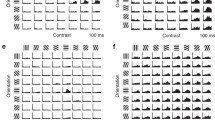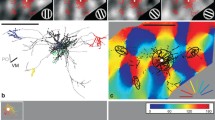Abstract
Most neurons in the primary visual cortex (V1) of mammals show sharp orientation selectivity and band-pass spatial frequency tuning. Here, we examine whether sharpening of the broad tuning that exists subcortically, namely in the retina and the lateral geniculate nucleus (LGN), underlie the sharper tuning seen for both the above features in tree shrew V1. Since the transition from poor feature selectivity to sharp tuning occurs entirely within V1 in tree shrews, we examined the orientation selectivity and spatial frequency tuning of neurons within individual electrode penetrations. We found that most layer 4 and layer 2/3 neurons in the same cortical column preferred the same stimulus orientation. However, a subset of layer 3c neurons close to the layer 4 border preferred near orthogonal orientations, suggesting that layer 2/3 neurons may inherit the orientation preferences of their layer 4 input neurons and also receive cross-orientation inhibition from layer 3c neurons. We also found that layer 4 neurons showed sharper orientation selectivity at higher spatial frequencies, suggesting that attenuation of low spatial frequency responses by spatially broad inhibition acting on layer 4 inputs to layer 2/3 neurons can enhance both orientation and spatial frequency selectivities. However, in a proportion of layer 2/3 neurons, the sharper tuning of layer 2/3 neurons appeared to arise also or even mainly from inhibition specific to high spatial frequencies acting on the layer 4 inputs to layer 2/3. Overall, our results are consistent with the suggestion that in tree shrews, sharp feature selectivity in layer 2/3 can be established by intracortical mechanisms that sharpen biases observed in layer 4, which are in turn inherited presumably from thalamic afferents.






Similar content being viewed by others
References
Bauer R, Dow BM (1989) Complementary global maps for orientation coding in upper and lower layers of the monkey’s foveal striate cortex. Exp Brain Res 76(3):503–509
Bauer R, Dow BM, Vautin RG (1980) Laminar distribution of preferred orientations in foveal striate cortex of the monkey. Exp Brain Res 41:54–60
Bosking W, Zhang Y, Schofield B, Fitzpatrick D (1997) Orientation selectivity and the arrangement of horizontal connections in tree shrew striate cortex. J Neurosci 17:2112–2127
Bullier J, Henry GH (1980) Ordinal position and afferent input of neurons in monkey striate cortex. J Comp Neurol 193:913–935
Conley M, Fitzpatrick D, Diamond IT (1984) The laminar organization of the lateral geniculate body and the striate cortex in the tree shrew (Tupaia glis). J Neurosci 4:171–197
Conway J, Schiller P (1983) Laminar organization of tree shrew dorsal lateral geniculate nucleus. J Neurophysiol 50:1330–1342
Creutzfeldt OD, Ito M (1968) Functional synaptic organization of primary visual cortex neurones in the cat. Exp Brain Res 6:324–352
Creutzfeldt OD, Kuhnt U, Benevento LA (1974) An intracellular analysis of visual cortical neurones to moving stimuli: responses in a co-operative neuronal network. Exp Brain Res 21:251–274
Crook JM, Kisvarday ZF, Eysel UT (1998) Evidence for a contribution of lateral inhibition to orientation tuning and direction selectivity in cat visual cortex: reversible inactivation of functionally characterized sites combined with neuroanatomical tracing techniques. Eur J Neurosci 10:2056–2075
DeValois KK, Tootell RBH (1983) Spatial frequency inhibition in cat striate cortex. J Physiol 336:359–378
Douglas R, Martin KAC, Whitteridge D (1991) An intracellular analysis of the visual responses of neurones in cat visual cortex. J Physiol 440:659–696
Ferster D (1986) Orientation selectivity of synaptic potentials in neurons of cat primary visual cortex. J Neurosci 6:1284–1301
Fitzpatrick D (1996) The functional organization of local circuits in visual cortex: insights from the study of tree shrew striate cortex. Cereb Cortex 6:329–341
Henry GH, Dreher B, Bishop PO (1974) Orientation specificity of cells in cat striate cortex. J Neurophysiol 37:1394–1409
Hubel DH, Wiesel TN (1962) Receptive fields, binocular interaction and functional architecture in the cat’s visual cortex. J Physiol 160:106–154
Hubel DH, Wiesel T (1968) Receptive fields and functional architecture of monkey striate cortex. J Physiol 195:215–243
Jain N, Preuss TM, Kaas JH (1994) Subdivisions of the visual system labeled with the Cat-301 antibody in tree shrews. Vis Neurosci 11:731–741
Jin JZ, Weng C, Yeh CI, Gordon JA, Ruthazer ES, Stryker MP, Swadlow HA, Alonso JM (2008) On and off domains of geniculate afferents in cat primary visual cortex. Nat Neurosci 11:88–94
Jin J, Wang Y, Swadlow HA, Alonso JM (2011) Population receptive fields of ON and OFF thalamic inputs to an orientation column in visual cortex. Nat Neurosci 14:232–240
Kremkow J, Alonso J (2018) Thalamocortical circuits and functional architecture. Annu Rev vis Sci 4:1–23
Kremkow J, Jin J, Wang Y, Alonso JM (2016) Principles underlying sensory map topography in primary visual cortex. Nature 533:52–57
Krüger J, Bach M (1982) Independent systems of orientation columns in upper and lower layers of monkey visual cortex. Neurosci Lett 31(3):225–230
Kuhlmann L, Vidyasagar TR (2011) A computational study of how orientation bias in the lateral geniculate nucleus can give rise to orientation selectivity in primary visual cortex. Front Syst Neurosci 5:1–18
Lee KS, Huang X, Fitzpatrick D (2016) Topology of ON and OFF inputs in visual cortex enables an invariant columnar architecture. Nature 533(7601):90–94
Levick WR, Thibos LN (1980) Orientation bias of cat retinal ganglion cells. Nature 286:389–390
Meese TS, Hess RF (2004) Low spatial frequencies are suppressively masked across spatial scale, orientation, field position, and eye of origin. J vis 4:843–859
Mohan YS, Jayakumar J, Lloyd EKJ, Levichkina E, Vidyasagar TR (2019) Diversity of feature selectivity in macaque visual cortex arising from a limited number of broadly tuned input channels. Cereb Cortex 29:5255–5268
Mooser F, Bosking WH, Fitzpatrick D (2004) A morphological basis for orientation tuning in primary visual cortex. Nat Neurosci 7:872–880
Movshon JA, Thompson ID, Tolhurst DJ (1978) Spatial summation in the receptive fields of simple cells in the cat’s striate cortex. J Physiol 283:53–77
Muly E, Fitzpatrick D (1992) The morphological basis for binocular and ON/OFF convergence in tree shrew striate cortex. J Neurosci 12:1319–1334
Naito T, Okamoto M, Sadakane O, Shimegi S, Osaki H, Hara SI, Kimura A, Ishikawa A, Suematsu N, Sato H (2013) Effects of stimulus spatial frequency, size, and luminance contrast on orientation tuning of neurons in the dorsal lateral geniculate nucleus of cat. Neurosci Res 77:143–154
Paik SB, Ringach DL (2011) Retinal origin of orientation maps in visual cortex. Nat Neurosci 14:919–925
Passaglia CL, Troy JB, Lukas R, Lee BB (2002) Orientation sensitivity of ganglion cells in primate retina. Vis Res 42:683–694
Priebe NJ (2016) Mechanisms of orientation selectivity in the primary visual cortex. Ann Rev vis Sci 2:85–107
Priebe NJ, Ferster D (2012) Mechanisms of neuronal computation in mammalian visual cortex. Neuron 75:194–208
Reid RC, Alonso JM (1995) Specificity of monosynaptic connections from thalamus to visual cortex. Nature 378(6554):281–284
Ringach D, Shapley RM, Hawken MJ (2002) Orientation selectivity in macaque V1: diversity and laminar dependence. J Neurosci 22:5639–5651
Rockland KS, Lund JS (1982) Widespread periodic intrinsic connections in the tree shrew visual cortex. Science 215:1532–1535
Rockland K, Lund JS, Humphrey AL (1982) Anatomical banding of intrinsic connections in striate cortex of tree shrews (Tupaia glis). J Comp Neurol 209:41–58
Schall JD, Vitek DJ, Leventhal AG (1986) Retinal constraints on orientation specificity in cat visual cortex. J Neurosci 6:823–836
Scholl B, Wilson DE, Jaepel J, Fitzpatrick D (2019) Functional logic of layer 2/3 inhibitory connectivity in the ferret visual cortex. Neuron 104:451–457
Shou T, Leventhal AG (1989) Organized arrangement of orientation-sensitive relay cells in the cat’s dorsal lateral geniculate nucleus. J Neurosci 9(12):4287–4302
Sillito AM, Berardi N, Kemp JA, Milson JA (1980) A re-evaluation of the mechanisms underlying simple cell orientation selectivity. Brain Res 194:517–520
Smith EL, Chino YM, Ridder WH, Kitagawa K, Langston A (1990) Orientation bias of neurons in the lateral geniculate nucleus of Macaque monkeys. Vis Neurosci 5:525–545
Sompolinsky H, Shapley R (1997) New perspectives on the mechanisms for orientation selectivity. Curr Opin Neurobiol 7:514–522
Van Hooser SD, Roy A, Rhodes HJ, Culp JH, Fitzpatrick D (2013) Transformation of receptive field properties from lateral geniculate nucleus to superficial V1 in the tree shrew. J Neurosci 33:11494–11505
Vidyasagar TR (1987) A model of striate response properties based on geniculate anisotropies. Biol Cybern 57:11–23
Vidyasagar TR, Eysel UT (2015) Origins of feature selectivities and maps in the mammalian primary visual cortex. Trends Neurosci 38:475–485
Vidyasagar TR, Heide W (1984) Geniculate orientation biases seen with moving sine wave gratings: implications for a model of simple cell afferent connectivity. Exp Brain Res 57:196–200
Vidyasagar TR, Mueller A (1994) Function of GABAA inhibition in specifying spatial frequency and orientation selectivities in cat striate cortex. Exp Brain Res 98(1):31–38
Vidyasagar TR, Sigüenza JA (1985) Relationship between orientation tuning and spatial frequency in neurones of cat area 17. Exp Brain Res 57(3):628–631
Vidyasagar TR, Jayakumar J, Lloyd E, Levichkina EV (2015) Subcortical orientation biases explain orientation selectivity of visual cortical cells. Physiol Rep 3:1–8
Vidyasagar TR, Pei X, Volgushev M (1996) Multiple mechanisms underlying the orientation selectivity of visual cortical neurones. Trends Neurosci 19:272–277
Vidyasagar TR, Urbas J (1982) Orientation sensitivity of cat LGN neurones with and without inputs from visual cortical areas 17 and 18. Exp Brain Res 46:157–169
Vitek DJ, Schall JD, Leventhal AG (1985) Morphology, central projections, and dendritic field orientation of retinal ganglion cells in the ferret. J Comp Neurol 241:1–11
Webster MA, De Valois RL (1985) Relationship between spatial-frequency and orientation tuning of striate-cortex cells. J Opt Soc Am A 2(7):1124–1132
Funding
The project was undertaken with financial support from the ARC Centre of Excellence in Integrative Brain Function, Australian Research Council (Grant no. CE140100007) and the Department of Optometry and Vision Sciences, University of Melbourne.
Author information
Authors and Affiliations
Contributions
Experiments were conceived and planned by YM, JJ and TRV. All authors participated in data collection. YM completed data analysis with assistance from SV and JJ. YM prepared the manuscript with support from TRV and EKJL. All authors provided critical feedback and helped shape the research and manuscript.
Corresponding author
Ethics declarations
Conflict of interest
There is no conflict of interest to report for this project.
Ethics approval
All experimental procedures were approved by the Florey Institute Animal Ethics committee and were conducted in accordance with the guidelines from the Animal Welfare Act 1992, The Animal Welfare Regulations (Vic) 1993 and the National Health & Medical Research Council’s Australian Code of Practice for the Care and use of Animals for Scientific Purposes (8th Edition, listed as EA28 in the NHMRC Publications Online Catalogue under ‘Animal Ethics’).
Consent to participate
Not applicable.
Consent for publication
All authors have consented to the publication of the manuscript in its present form.
Availability of data and material
The data that support the findings of this study are available from the corresponding author upon reasonable request.
Code availability
All custom code relevant to this study are available from the corresponding author upon reasonable request.
Additional information
Publisher's Note
Springer Nature remains neutral with regard to jurisdictional claims in published maps and institutional affiliations.
Supplementary Information
Below is the link to the electronic supplementary material.
Rights and permissions
About this article
Cite this article
Mohan, Y.S., Viswanathan, S., Jayakumar, J. et al. Mechanism underpinning the sharpening of orientation and spatial frequency selectivities in the tree shrew (Tupaia belangeri) primary visual cortex. Brain Struct Funct 227, 1265–1278 (2022). https://doi.org/10.1007/s00429-021-02445-y
Received:
Accepted:
Published:
Issue Date:
DOI: https://doi.org/10.1007/s00429-021-02445-y




